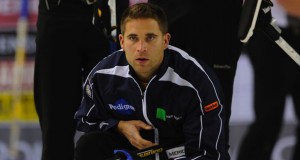Fit to Curl: The between-game workout.
Medicine Hat hosted a Canada Cup that was great in every way except for, well, the way that final game turned out. (Actually, even that was good for the fans. While I’ll never get used to losing, Glenn Howard made a beauty to win.)
Despite the fact that Medicine Hat isn’t a big urban centre, we had terrific accommodations and I was happy to find that the hotel had a solid gym — lots of good cardio equipment, some free weights and Nautilus-style machines.
You might think that during a meat grinder like the Canada Cup — a really tough field, ten-end games, a mid-week start — a workout is the last thing a curler needs. While there’s no question that rest and recovery is critical when you’re competing, I’ve found that getting in some sort of cardio and light strength training really makes a difference in the way I feel on the ice. I’m not alone among elite curlers either — the first time I went down to the gym at the hotel, I ran into fitness fanatic Cheryl Bernard, midway through her own workout.
Sure, there was a time in my career when my schedule at big events was basically curl, nap, curl, sleep, curl again. I probably found a bit of time for socializing, too. But most of my downtime involved hanging around in my hotel room, watching the tube and arguing about football — or something — with Ben Hebert.
I’ve found, however, that just killing time isn’t the best way for me to prepare to play. Now, during extended breaks, exercise is on the docket. If my typical day includes a workout, why would I decide to go five days or more without getting one in?
Here’s the kind of workout I like to do when I head to the fitness centre during an event:
• 30 minutes of cardio. I’ll use a bike, an elliptical or a treadmill, depending upon my mood. I’ll mix in some high-intensity intervals — working at 90% of my Heart Rate Maximum — during that half-hour. But I won’t push things too much — the bulk of the workout will be at 60-70% of my HR Max.
• A short circuit. Again, I’m not looking to push myself too far but because I work out throughout the season, I know that I won’t wind up with sore muscles after doing some strength training. A circuit I like during an event is Chin-Ups (both Close and Wide Grip), Push-Ups (with my feet elevated on a bench to make them a bit more challenging), Bicep Curls (Hammer and Concentrated) and Tricep Extensions. I’ll do three sets of each, keeping the weights in a comfortable range, and probably be done in about 25 minutes.
Now someone might say that curling a ton of high-pressure games is a workout itself. It’s true that if you’re playing a sweeping position, you’re burning a ton of calories on the curling ice. And if we have a two-game day, particularly when they go ten ends, I’m probably not going to have time for the gym.
But I’ve come to realize that a crisp workout during down time goes a long way towards helping me feel physically ready when I’m on the ice. I don’t tend to lie around in bed all day when I’m not competing so doing that when I am playing throws things off. While rest and recovery is definitely important, keeping on track with my workouts helps me feel energized and positive.
Of course, I’d only recommend this if you’ve continued your off-season training during the winter. That’s important, too. While curling is a workout, you don’t want to rely only on playing and practicing in order to maintain the fitness level that you worked hard to achieve over the summer. If you have continued to train once the season got underway, you can complete a light workout during an event without needing to fear that you’ll wind up with sore muscles later.
It’s all part of a balanced approach to fitness and good health. It certainly won’t make it any easier on your mind when you watch your opponent make a great shot to beat you. But at least your body will feel good.





